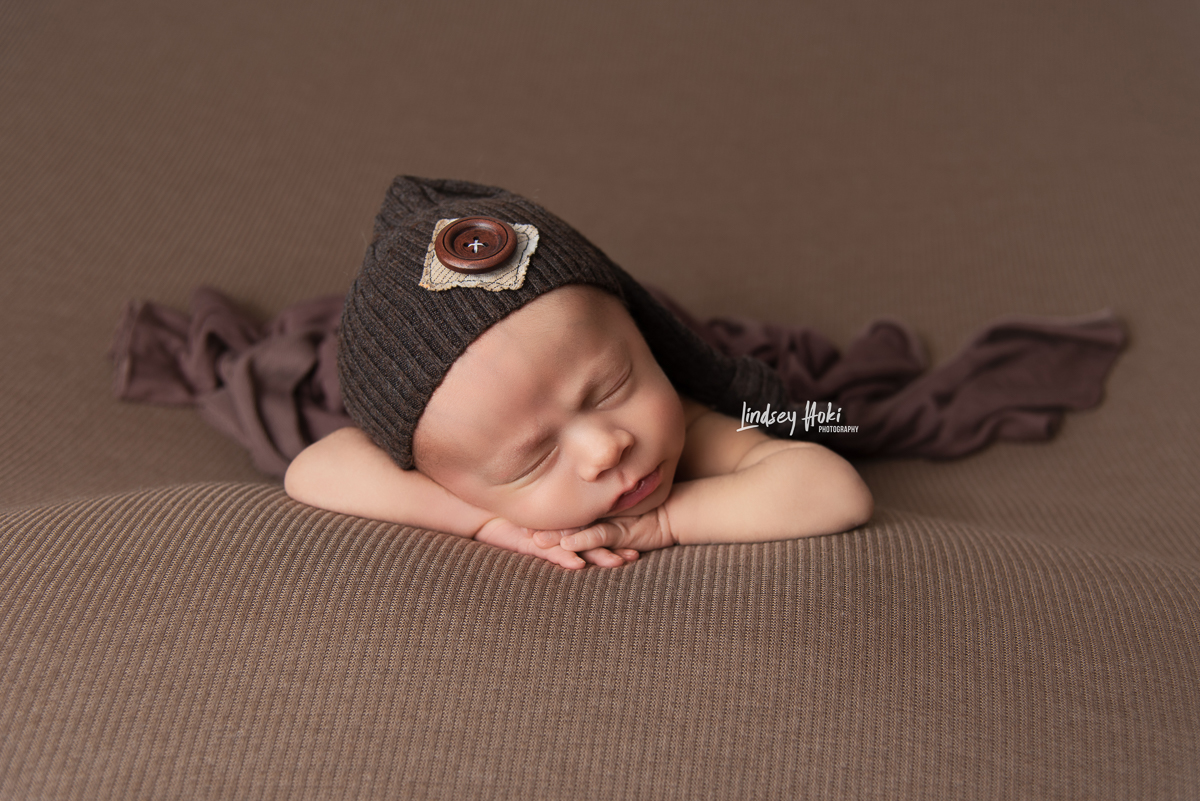
A baby is often fussy so they can signal that they have a need. Newborn photographers should learn as much as possible about newborn babies including their cues, why they cry, soothing techniques, and their behavior and mechanics. There are cues that babies give when they are hungry, scared, or hurt. By recognizing the baby’s cues, photographers can help tend to their needs quickly and keep them comfortable and happy.1 By responding quickly, a truly professional newborn photographer can hopefully prevent an excessively crying baby and have a more successful photo session.
Some babies are going to be fussier and more sensitive than others. The most common reasons why babies cry are hunger, sleepiness, poo or pee, gas, need to burp, body temperature, not enough stimulation, or too much stimulation.1 The photographer must be able to adjust the session to the baby’s needs and comfort. If the baby is fussy it may take 15 minutes on one pose, where others will only take a few minutes. The baby’s best interest should always be the priority.2
The rooting and sucking reflex is a survival cue that we can use to recognize that the baby is hungry. When something touches the baby’s cheek, they will turn their head that direction looking for food. Some babies will try to suck on their hands when hungry. When a baby is showing these cues, it is best to feed the baby, even before they start crying.1
Pacifiers can be used as a way to settle and soothe the baby. “The sucking reflex comes from deep within the nervous system and triggers a calming response from the baby”.1 Binkies or pacifiers may be helpful during sessions to keep the baby calm and satisfied, although whether or not to use pacifiers should be decided by the parents. Having extra, unused, sterile binkies on hand can be helpful if parents forget to bring one to the photo studio.

Newborns cannot soothe themselves, so it is important to know how to soothe them. Both photographers and parents need to remain calm and that will help the baby to be relaxed. Dr. Harvey Karp’s, The Happiest Baby on the Block identifies the 5 S’s that can help to calm a baby: swaddling, shushing, swinging, sucking, and side/stomach position.1 Babies can be calmed by white noise, lullabies, lightly stroking between the eyes, or shoulder massages.1 As an experienced newborn photographer, I have also found that lightly patting the baby, rocking them back-and-forth, or light vibration can also be soothing.
If the baby suddenly screeches, that indicates something the baby does not like, such as the baby may not like the position, their hand is bent uncomfortably, or their still healing umbilical cord is caught on the fabrics. Take a look at everything that was happening when the baby screeched to try to determine what upset them. Be slow with movements and readjust the baby if needed.1

Finally, newborn babies can be startled easily. Some things that may cause a baby to startle are loud noises, bright lights, sudden movements, a sense of falling, or their own cry. We cannot always prevent a startle reflex, as sometimes it is caused from within. It is important to maintain a quiet environment that will not overstimulate the baby.1 Photographers should be cautious of a baby’s reflexes, especially when they are posed or in a prop; never be more than a foot away from the baby when on the posing surface.3 The startle reflex could cause a baby to lunge or roll and this is dangerous when not properly watched or spotted. Babies will flail their arms if they do not feel secure. When moving the baby, help them to feel secure by gently holding down their arms.1
By paying attention to the cues the baby gives and attending to a baby’s needs, we can keep the baby settled and comfortable, as well as reduce complications during the session.
Sources
- Long, R. (2013). The anatomy of a newborn. Natural Newborn Baby Photography: A Guide to Posing, Shooting, and Business. [electronic resource]. Peachpit Press. Retrieved from http://search.ebscohost.com.ezproxy.uvu.edu/login.aspx?direct=true&db=cat07712a&AN=flc.303455&site=eds-live
- Long, R. (2013). Newborn posing. Natural Newborn Baby Photography: A Guide to Posing, Shooting, and Business. [electronic resource]. Peachpit Press. Retrieved from http://search.ebscohost.com.ezproxy.uvu.edu/login.aspx?direct=true&db=cat07712a&AN=flc.303455&site=eds-live
- Long, R. (2013). The planning stage. Natural Newborn Baby Photography: A Guide to Posing, Shooting, and Business. [electronic resource]. Peachpit Press. Retrieved from http://search.ebscohost.com.ezproxy.uvu.edu/login.aspx?direct=true&db=cat07712a&AN=flc.303455&site=eds-live





